
The banded bullfrog is a species of frog in the narrow-mouthed frog family Microhylidae. Native to Southeast Asia, it is also known as the Asian painted frog, digging frog, Malaysian bullfrog, common Asian frog, and painted balloon frog. In the pet trade, it is sometimes called the chubby frog. Adults measure 5.4 to 7.5 cm and have a dark brown back with stripes that vary from copper-brown to salmon pink.
Eligminae is a subfamily of the moth family Nolidae.

Armactica conchidia, the conchidia moth, is a moth of the family Nolidae first described by Arthur Gardiner Butler in 1886. It is found in Australia.

Diphthera festiva, the hieroglyphic moth, is a species of moth in the family Nolidae and is the only moth in its subfamily Diphtherinae. It is found in the tropical and subtropical areas of South America, Central America, North America, and the Caribbean. In North America, the species has a southeastern distribution from South Carolina west to Texas along the Gulf Coast. Strays have been recorded as far north as Michigan and Missouri. The wingspan is 37–48 mm (1.5–1.9 in). This species is occasionally considered a pest on soybeans. It was described by Johan Christian Fabricius in 1775.
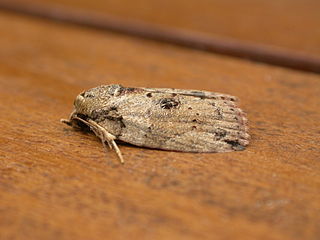
Nanaguna breviuscula, the pigeonpea pod borer, is a moth species of the family Nolidae. It is found from Sri Lanka and India east to Samoa. In Australia it is found in the Kimberleys in Western Australia, the northern part of the Northern Territory and from the Torres Strait Islands and Queensland to Sydney in New South Wales.
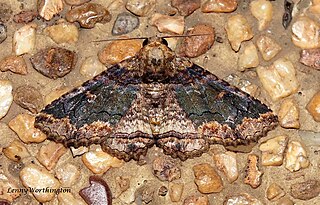
Pericyma cruegeri, the poinciana looper, is a moth of the family Erebidae. The species was first described by Arthur Gardiner Butler in 1886. It is found in south-east Asia including Hong Kong, Taiwan, Vietnam, Thailand, Sumatra, Peninsular Malaysia, Borneo, the Philippines, New Guinea, and in Australia, northern New South Wales and Queensland. Furthermore, it is an introduced species in Hawaii and Guam, where it was first detected in 1971. In Japan, it was first detected in 1986 in Ishigaki Island and the living area is expanded to Okinawa Island by 2000.
Meganola brunellus is a moth of the family Nolidae. It is found in Sri Lanka, India, Taiwan, Japan, the Ryukyu Islands, Sundaland, Queensland and the Bismarck Islands. It is an introduced species in Hawaii.

Armactica columbina is a moth of the family Nolidae first described by Francis Walker in 1865. It is found in the Australian states of New South Wales, Queensland and the north of Western Australia.

Kerala is a genus of moths of the family Nolidae erected by Frederic Moore in 1881.
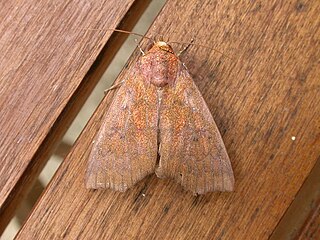
Anomis nigritarsis is a species of moth of the family Erebidae. It is found in Sri Lanka, India, China (Hainan), Taiwan, Borneo, Java, Sulawesi, the Moluccas, Queensland, New Caledonia, the Solomon Islands, Vanuatu, Fiji, Samoa and Tonga.
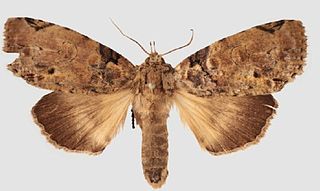
Gadirtha is a genus of moths of the family Nolidae.

Gadirtha fusca is a moth of the family Nolidae. It is found in east-central and south-eastern China.
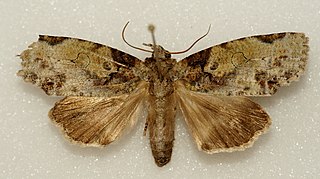
Gadirtha inexacta is a moth of the family Nolidae first described by Francis Walker in 1858. It is found in northern India and Myanmar, as well as on Borneo. It has also been recorded from Queensland and New South Wales in Australia.

Gadirtha impingens is a moth of the family Nolidae first described by Francis Walker in 1858. It is found from northern India and southern China to Queensland, the Bismarck Archipelago and the Solomon Islands, as well in Japan. The habitat consists of lowland areas up to 2,600 meters, but it is most frequent at elevations ranging from 1,000 to 2,000 meters.

Baileya australis, the small baileya moth, is a moth of the family Nolidae. The species was first described by Augustus Radcliffe Grote in 1881. It is found in North America, where it has been recorded from Quebec and New York to Florida, west to Texas, north to North Dakota and Ontario.

Urapteroides is a genus of moths in the family Uraniidae.

Maceda mansueta is a moth of the family Nolidae first described by Francis Walker in 1857. It is found in Japan, Sri Lanka, Borneo, India (Andamans), Malaysia, New Guinea, Fiji, Australia, Réunion and the Seychelles.
Lasiolopha saturata is a moth of the family Nolidae first described by Francis Walker in 1865. It is found in Oriental tropics of India, Sri Lanka, Thailand, New Guinea and Australia.
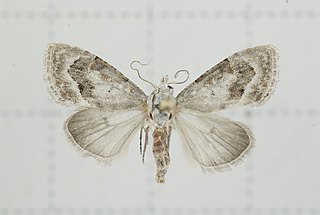
Nola fasciata is a moth of the family Nolidae first described by Francis Walker in 1866. It is found in Indo-Australian tropics of India, Sri Lanka to Borneo, Taiwan, New Guinea and Australia.
















